Complete Explanation of Google SERP Features
How to
As we all know, the evolution in the digital world has urged businesses to develop their online presence to compete with their rivals in the race of SERP rankings. The higher the ranking, the more will be the CTR.
In this blog post, I’ll surface the main SERP features and explain how to get there.
- 1. What Are SERPs and Its Features?
- 2. Featured Snippets (Answer Box)
- 3. Knowledge Panel
- 4. People Also Ask
- 5. Local Pack
- 6. Local Teaser Pack
- 7. Twitter Packs
- 8. Sitelinks
- 9. Reviews
- 10. Image Pack
- 11. Videos
- 12. Google Ads
- 13. Accelerated Mobile Pages (AMP)
- 14. Shopping Results
- 15. Key Suggestions to Optimize Your Content and Website for Result-Driving SERP Features
1. What Are SERPs and Its Features?
In general, whenever a user searches for a specific keyword, the webpage that displays results is referred to as the search engine result page (SERP).
Every SERP is unique according to the searched keywords and may encompass organic results, paid results, and SERP features altogether.
Whereas, SERP features could be referred to as auxiliary elements that help users dig out the required information more effectively, enhancing their experience, and assist the companies in building their brands.
Below is a sample search for the keyword ‘types of the ecosystem’:
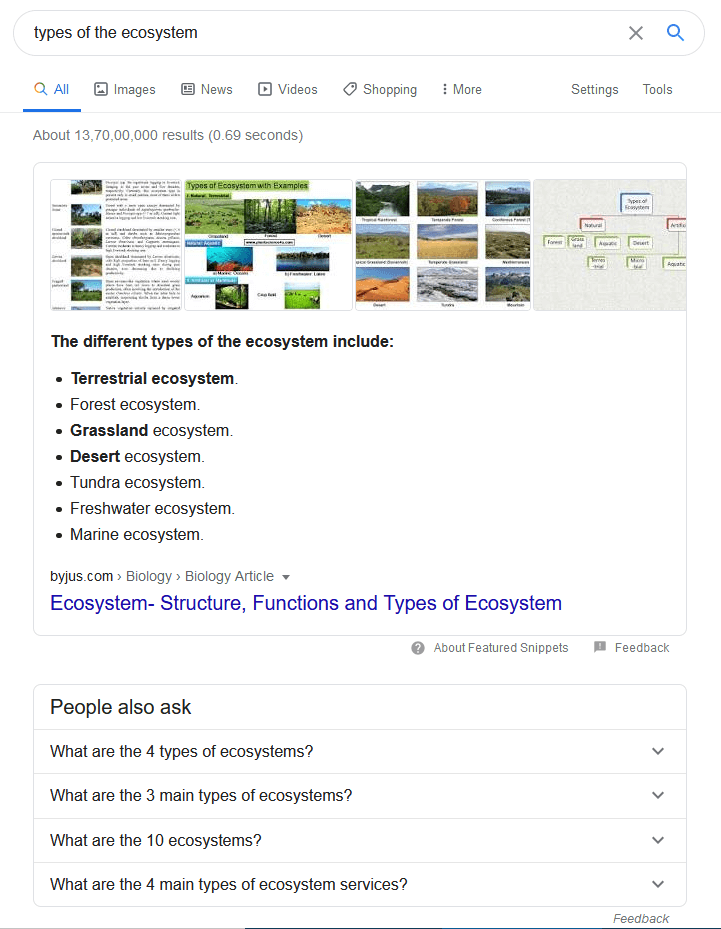
The above search result shows ‘featured snippets’ and ‘People also ask’ features for the users to effectively find the answers to their queries.
Likewise, other SERP features are, as well, beneficial for both the searchers to effectively search for their queries and for the marketers to stand out in the SERP to allure the targeted audience. Now let’s list the most common SERP features that users encounter on Google.
2. Featured Snippets (Answer Box)
Usually pinned at the top of the SERP, the featured snippet box renders the information being pulled by the website resource and the website link. It largely acts as a quick response to a typical question.
Thereby, it is also known as an ‘answer box’. For that reason, the featured snippets generally make it needless for the users to click over any search result.
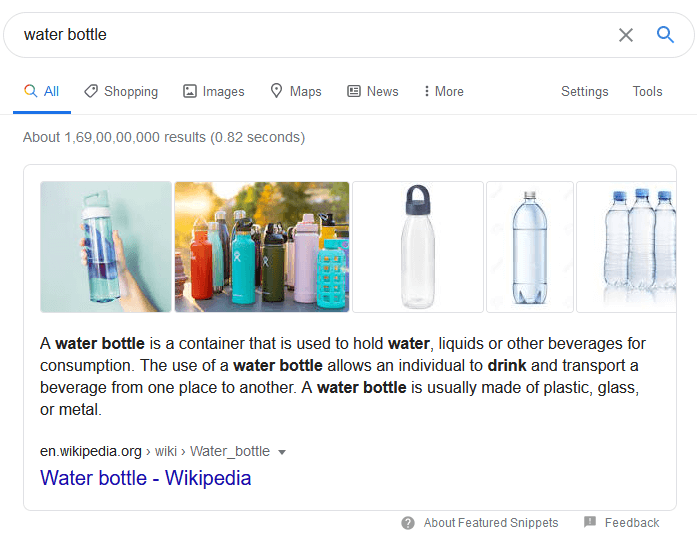
The above example shows the top positioning of the featured snippet for the query ‘water bottle’.
Since it has been positioned on the top page, featured snippets steal clicks from the #1 ranking results, according to Ahrefs study.
2.1. How to Get Yourself to Appear in Featured Snippets
It should be noted that chances to rank out #1 on the SERP are probably minimal. However, it is always as controversial as to how Google considers a perfect answer to a featured snippet query.
- Include keywords into the title tag and <h1> tag:analyze what questions are being asked by the users related to your keywords. For the featured snippets, try to include the entire search query in the page title.
<title>Ecommerce Website Structure and How to Get it Right – Netpeak Software Blog</title>
- Leverage schema markup. Since Google uses schema markup to analyze the page content, it is vital to augment Google’s opportunities to consider your page as relevant and authoritative.
- Use rel=“publisher” tag to strengthen the credibility of your links.
3. Knowledge Panel
Knowledge panels are the information boxes that are displayed on the right side of the Google SERPs. Usually, knowledge panels are displayed for a query about a famous thing, place, or person.
The users are provided with the necessary information in this box for the searched topic, refraining them from clicking through the search results. Google automatically drives brief information from various sources over the web to make it available for the users within the knowledge panels.

3.1. How to Get Yourself to Appear in Knowledge Panel
Well, grabbing a knowledge panel entails various steps:
- If your brand appears when users search for your brand keywords, you can simply hit the ‘Claim this Knowledge Panel’ button below the box.
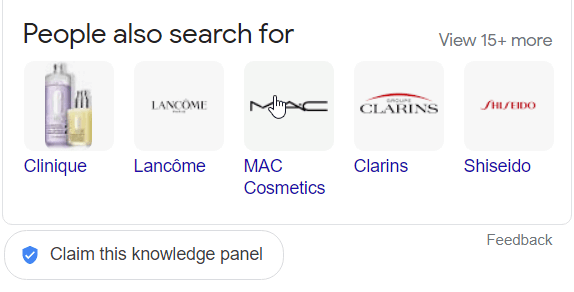
- Create a personal page on Wikipedia.
- Get a brand page authentication badge from social networks so that Google can identify accounts.
- Use Schema.org markup, which translates the page content to the search engine and simplifies data extraction.
In case your goal is to get into Local Knowledge Local Graph, create a Google brand account and provide detailed (in-depth) information: opening hours, contact phone number, address and route, reviews. And wait. Google doesn’t guarantee that business profile data will appear in the Local Knowledge Graph and doesn’t disclose the applicants selection principle.
4. People Also Ask
Have you ever encountered similar questions to your query in the search results? That section is known as ‘People Also Ask’. Each question, upon clicking, further unfolds a featured snippet along with additional questions.
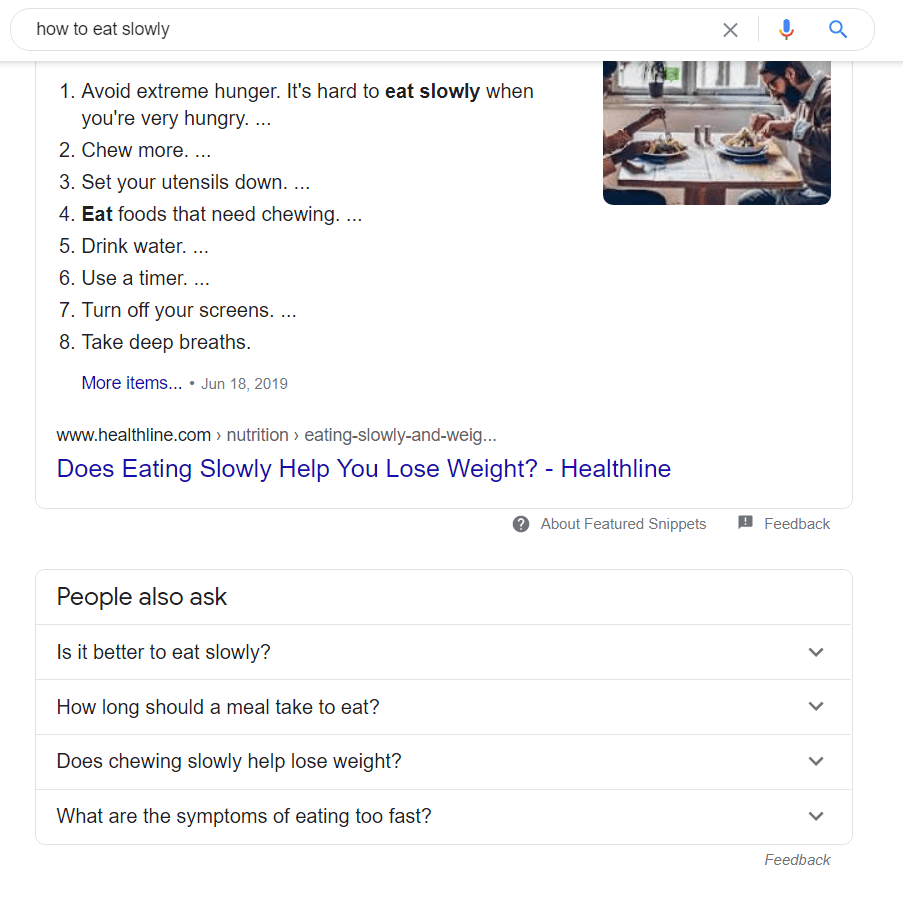
The questions in this section are basically the collection of the featured snippets similar to the searchers’ intent. They are formed based on Google's calculations of what is relevant to the topic. This assists the users to have their hands over other matching topics in a single search query.
4.1. Can You Get Featured in PAA?
To find yourself in the ‘People also ask’ section, try using the Featured Snippet algorithm. Like with featured snippets:
- Add semantic-rich search keywords to your content to expand the reach by offering more depth and context. Ensure as to whether or not you are fully answering to what the user is searching for.
- Leverage Google Search Console reports for inspecting the primary keywords that are triggering PAA’s.
- While creating responsive content around a keyword, use those questions as a latent semantic index (LSI) to cover the topic in depth.
5. Local Pack
If you want to find a place to eat or do sports, be sure Google will show you a map with a list of places that might stoke your interest. Search results with local intent are often encompassed in the local pack block. This pack usually dwells below the paid ads on the Google SERPs.
The Local pack results are quite popular with mobile voice searches and are effective enough to allure the users to click through the business links.
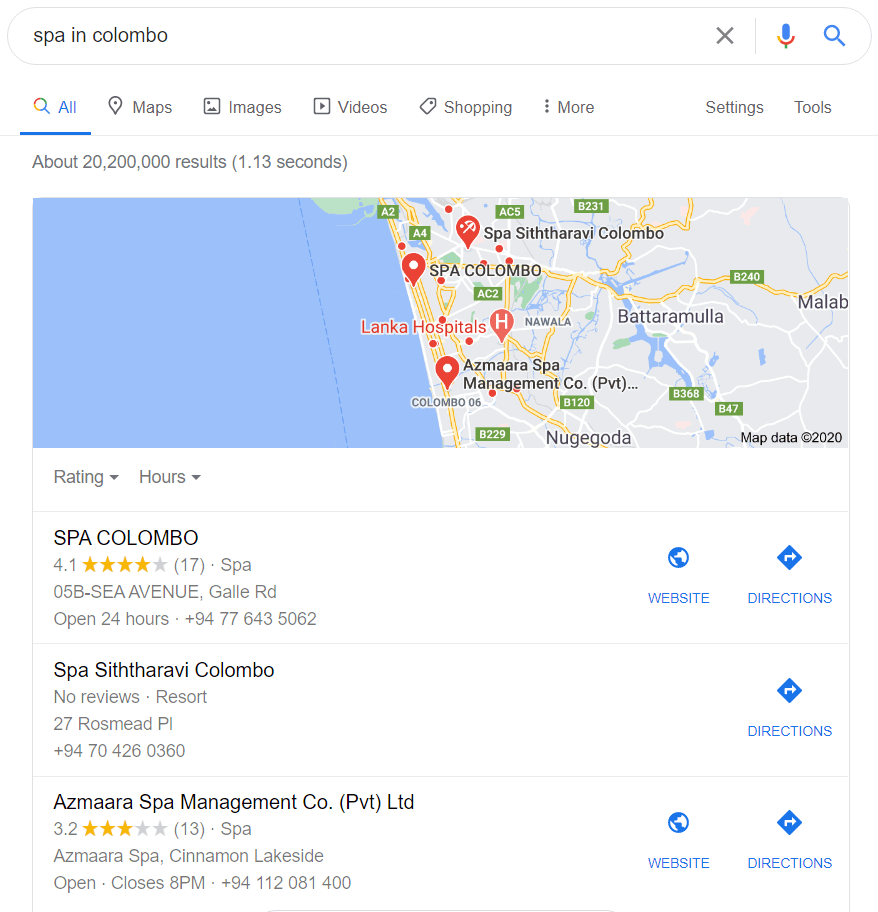
A typical Google local pack entails a map location, rating stars, and opening hours of the top three businesses, as shown in the image above.
5.1. How to Get Your Business in Google Local Pack?
If you are running a local business, then Local Pack is just what you need. You need to:
- Create the Google My Business account first. It should be an all-encompassing informative account for your business, including map location, working hours, NAP (name address, phone numbers).
- Make sure to grab as many reviews and star ratings as possible to augment the probability of getting ranked higher in local listing.
- Bear in mind the benefits of a website's on-page optimization and local content creation in enriching your business's local rankings.
6. Local Teaser Pack
The Local Teaser Pack seems identical to the Local Pack but has minor differences.
However, the chief difference being that the local teaser pack features mostly hotels and restaurants, while the local pack exhibits a variety of businesses.
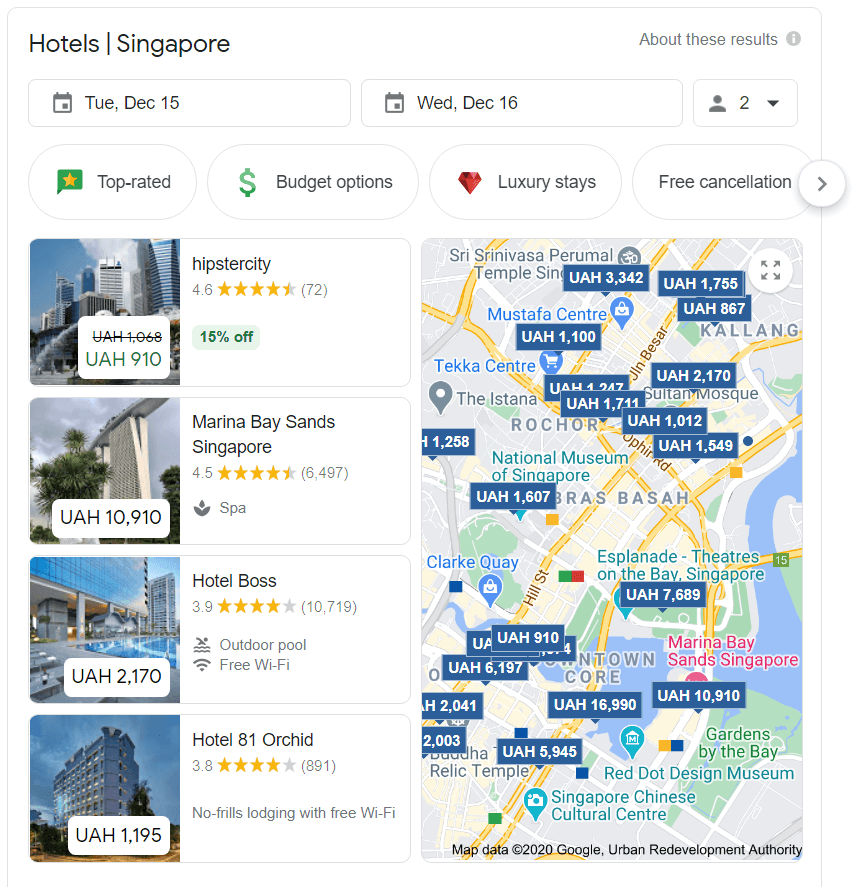
Even though the local pack offers relevant information, Google has introduced a local teaser pack. But why? Well, local teaser packs essentially yield additional information to the users, such as pricing, amenities, and much more, in contrast to the local packs.
6.1. How to Feature Your Business in the Local Teaser Pack List
Well, the factors that influence the business’ ranking for local teaser packs are almost the same as for the local pack.
However, many experts suggest that Google is testing out whether or not the local teaser works excellent with restaurants and hotels.
7. Twitter Packs
Years back, Google partnered with Twitter for data indexing. Thereby Google SERPs tend to showcase the most recent tweets relevant to the searched query in the form of Twitter packs displayed after a few organic results.
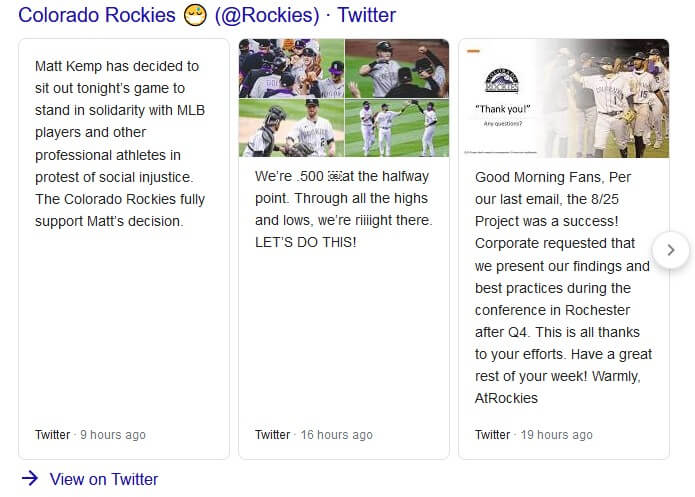
The tweets are displayed in the form of a sliding carousel. The users can move from one tweet to the next by using the arrow buttons. The time of the posted tweet is also shown below, along with the direct Twitter link.
However, Twitter packs are one-dimensional as they merely generate brand awareness rather than rendering adequate information to the users.
7.1. How to Boost Your Tweets for Google Search?
Twitter regularly indexes your bio. Hence optimization of your Twitter bio is imperative to amplify your reach. Also, include the keywords in your tweets, and make all the efforts to enrich the profile credibility by sharing your Twitter links to other social media channels.
Unlike other SERP features, you cannot link your website to these packs but only the Twitter accounts.
8. Sitelinks
To enrich the search results, Google displays the featured pages of your website as clickable links. These sitelinks are the additional links to your website that appear below the main URL when people search for the relevant keywords.
Upon clicking the links, the users will be driven directly to the specific page on your website.
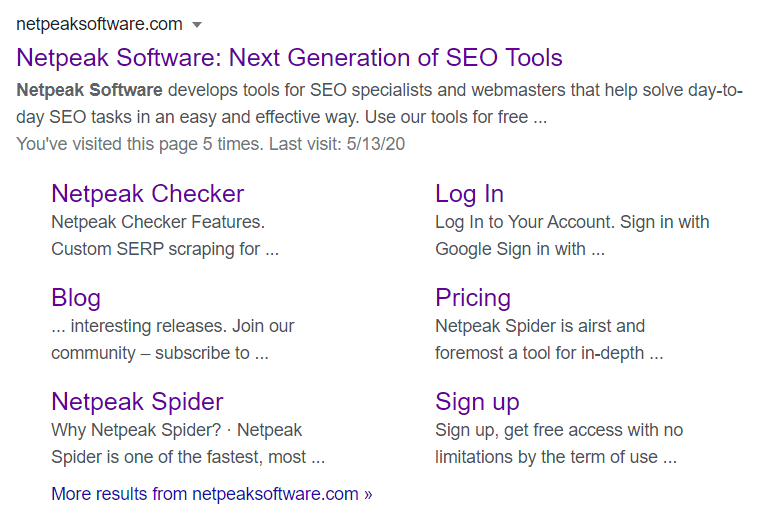
The main goal of the sitelinks is to allow users to navigate the main pages of the large website from within the SERPs.
8.1. How to Create Sitelinks
The crucial aspect of creating the sitelinks is the website structure, which should be easy and straightforward for both Google and the users. According to Google guidelines, a hierarchical website structure assists Google in crawling and indexing while providing an easy map to follow.
Also, build more internal links to the pages, which you want to be listed in the sitelinks.
9. Reviews
Review snippets are a brief insight into the business or any product based on the average rating scores given by many reviewers. Having a review snippet could certainly be fruitful, as the star ratings are often regarded as the social proof and render credibility to the business.

This SERP feature displays the rating on a scale of 1-5 in the form of both stars and numeric representation. A summary is also displayed underneath, which entails a total number of reviews or votes.
According to Accuranker, the results with reviews could yield higher CTR than the results with no star ratings.
9.1. How to Markup your Reviews for Star Ratings in SERP
Structured data renders detailed information about the page and is used to classify the page content. Therefore, the structured markup is used to enrich the snippet by adding a few more details such as reviews, star ratings, number of votes, and much more. The markup used for the reviews is Schema.org/review, along with the properties that must be included. However, those properties could also be embedded into other types.
Aggregate the star ratings for each product and make it appear in the SERP by using AggregateRating.
10. Image Pack
The image feature is quite promising for drawing the user’s attention. The image pack appears whenever Google deems images as a more relevant element for the search result. By clicking on the image, you will be taken to the image page, from where you would be directed to the website upon clicking the image.
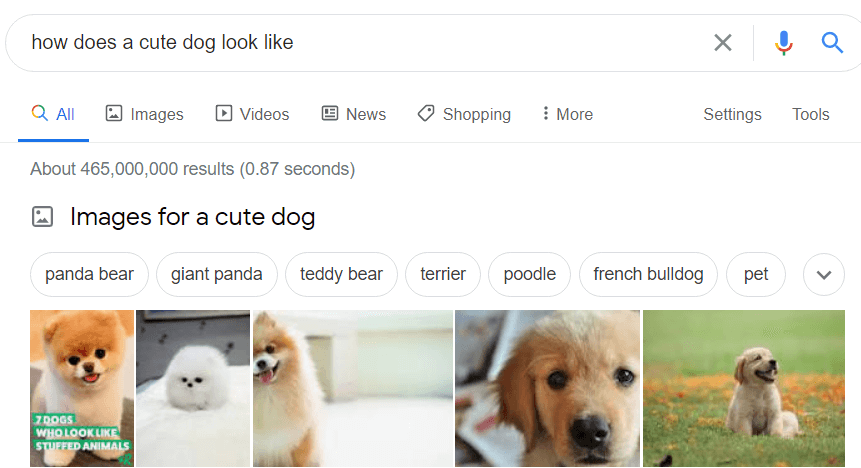
Images in Google Images get ranked according to a special algorithm beyond the organic search. Your image optimization should be top-notch to have your image visibility in the Google SERPs.
10.1. How to Get Images Visible in the Google SERPs
For the image to be indexed by Google for Image pack, choose a descriptive filename and ALT image tag.

As done in the above image, you should adequately describe the content of your picture in the ALT tag to rank better in SERP.
11. Videos
Video content captures the audience's attention and entices for a longer page view. Video is displayed above the search results to informational, commercial, multimedia, and other types of queries with a possible visual intent. This feature works mainly for large sites with video content (YouTube, Vimeo).

11.1. How to Feature Your Video on Google SERP?
Again, it is vital to deploy appropriate video schema markup for a better understanding and indexing of your video content.
The must-have structure data property is VideoObject for video-rich SERP results.
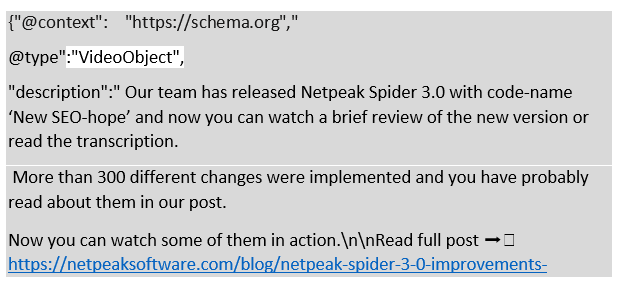
However, you can also include recommended properties to describe the content effectively. To enable video enhancements in Google, you can add the following data types:
- BroadcastEvent. Use this property to mark up the event videos with a live badge that are being broadcasted, such as a sporting event or an awards ceremony.
- ItemList. Use this property to markup the list of videos to be featured in the form of a video host carousel in the SERP results.
12. Google Ads
Google Ads basically rank on the first 4-5 positions of the SERP, but at a cost. This is a paid SERP feature that helps businesses market their products effectively and generate sales leads.
However, the pricing for the ads could vary according to the keyword search volume in the form of CPC (cost per click) or CPM (cost per 1000 reach).
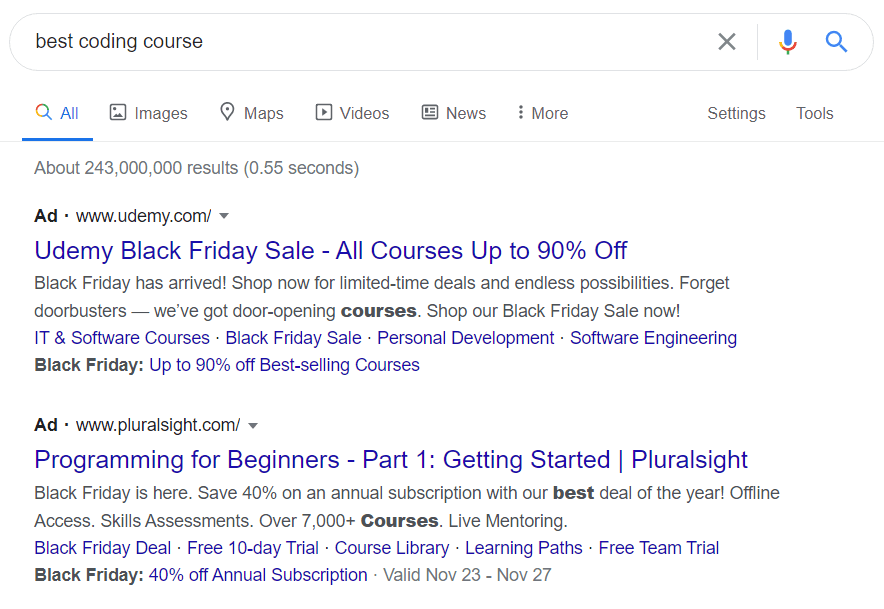
12.1. How to Acquire the Top Position of the Google Ad Listing?
Well-tuned ads targeting certain geolocations and time intervals significantly increase website traffic and lead to a large number of leads. To get the most out of your advertising campaign:
- Choose a relevant group of keywords.
- Analyze how competitive the niche you go into is.
- Go through the bids of other applicants for getting into the Google Ads block.
Every search result is followed by a process called ad auction. This auction determines which ad will appear in the SERP and at what position. The Ad Auction leverages Ad Rank to determine the position of your ad.

Even if your bid amount is lower than your competitor, you can still be able to achieve a higher ranking merely by enriching the quality of your ad according to several Ad rank factors:
- The bid amount: More the bid, higher the chances. You can change your bid at any time.
- Quality of ads and landing page: To achieve a high-quality score in the ad quality assessment, the ads and the landing page should be more relevant to the users.
- Adhering to the ad rank thresholds.
- Relevancy to the searched query.
In general, higher-quality ads usually drive lower costs, enhanced ad positions, and promotion success.
13. Accelerated Mobile Pages (AMP)
Google’s share of 95.6% for global mobile search traffic has inspired the search engine to devise mobile-friendly features.
AMP (Accelerated Mobile Page) is a lightweight version of a usual web page free from the elements such as cookies, third-party JavaScript, and slow ad-network.
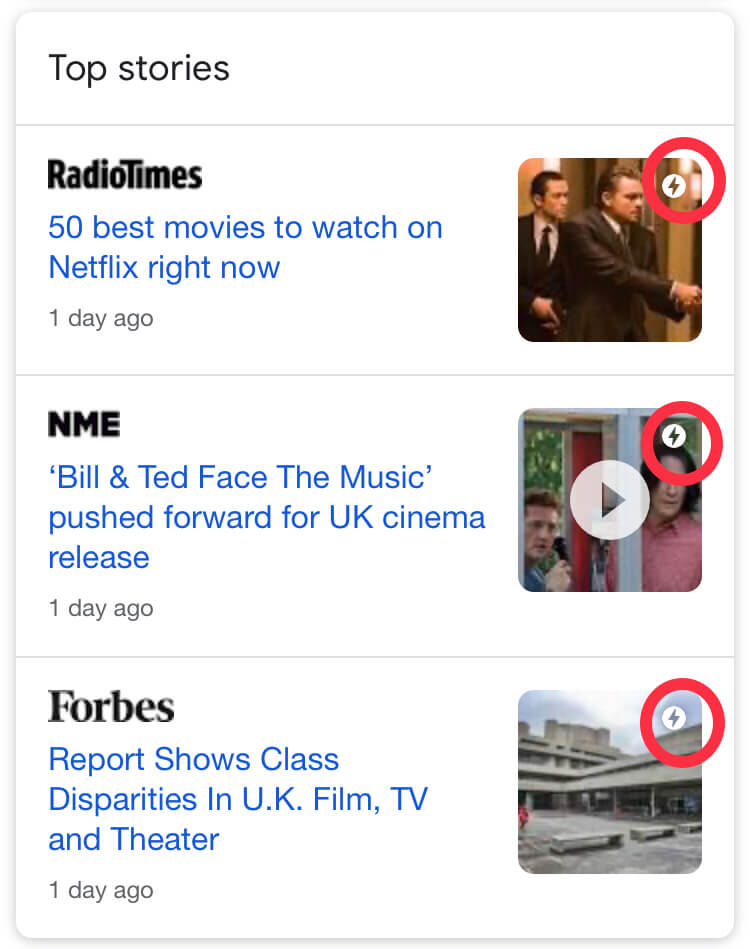
AMP tends to be a great way to leverage mobile search result performance. Usually, AMP is showcased in a carousel featuring news results and optimized articles and is marked with an icon, as shown in the above image.
Though it’s an extensive process to develop AMP pages, you should optimize these pages by adding information about the AMP pages to the non-AMP pages and vice versa.
Add rel=’amphtml” (for AMP) and rel=”canonical” (for non-AMP) versions as <link> tag in the <head>.
This added information will enhance the discoverability of your AMP pages, and hence leverages the Google search ranking.
14. Shopping Results
Shopping results are also termed as Product Listing Ads (PLAs). It is another paid SERP feature powered by Google Merchant Centre, which appears in response to queries with commercial intent.
Like Google ads, it sits on the top of the SERP, left side or the bottom, and reaps quality leads for the advertising businesses.
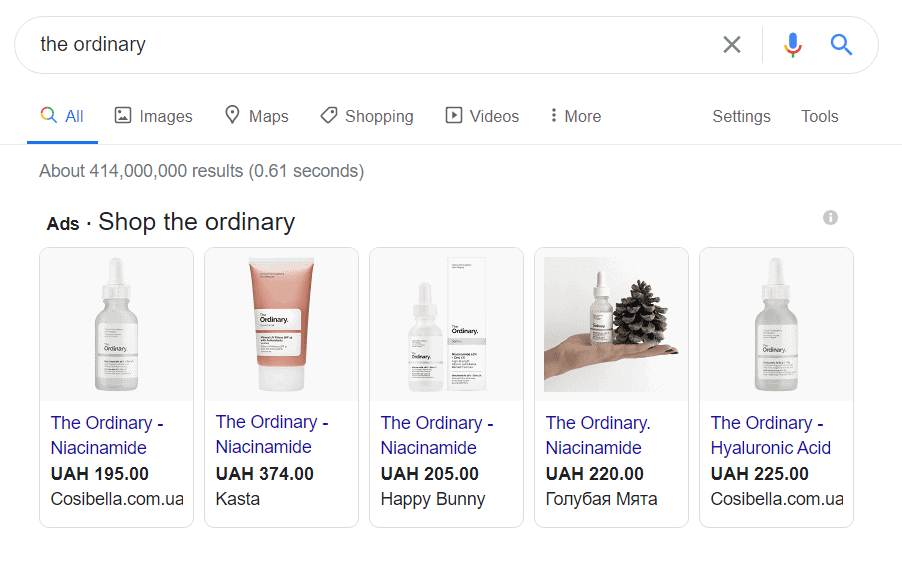
Owing to the descriptive ads, which encompass prices, product name, star ratings, the shopping ad feature has become a favorite SERP feature for online retailers.
14.1. How to Make the Products Appear in the Shopping Results?
The first step to feature your products in Google shopping results is to sign up for a Google Merchant Center account.
Now optimize your images to make it familiar for Google indexing. After the appropriate optimization of the images, visit the Google Merchant Center account to create the product data feed.
The product feed will assist Google in effectively recognizing the information about the products in the form of attributes comprising:
- Product id
- Product title
- Description
- Landing page URL
- Image link URL
- Availability
- Product price
- Product brand
- Google product category
Now it's time to join the dots by linking the Google Merchant Center account with your Google Ads account for creating effective Google Shopping campaigns.
After Google shopping campaign setup, build ad groups for your campaign, which are available as Product shopping ad group and Showcase shopping ad group.
For promoting a single product choose the maximum CPC (Cost per Click) bid for the Product Shopping Ad group. Whereas, for the promotion of multiple products, you will have to set up the maximum CPE (cost per engagement) bid for the Showcase Shopping Ad group. Click the Save button, and you’re done!
15. Key Suggestions to Optimize Your Content and Website for Result-Driving SERP Features:
- The foremost aspect is to enrich the website backend by leveraging structured data (schema markups), interlinking the content, creating and maintaining sitemaps.
- Do focus on keyword research to have insights into which content type usually ranks and then create the content according to the relevant keywords.
- Try to answer the audience in a more appropriate way than how your competitors are doing.
Summing Up
Gone are the days when the searchers have to dig out several websites for quick information. Now Google has devised expedient methods to provide information appealingly.
Search engine result pages do not merely display the URLs but also comprise several features to optimize for.
Marketers could leverage the above-mentioned SERP features as a part of their effective marketing plan. However, make sure to decide which SERP feature you would employ before embarking on your content strategy. This will assist in rendering a fair vision for your content creation.


